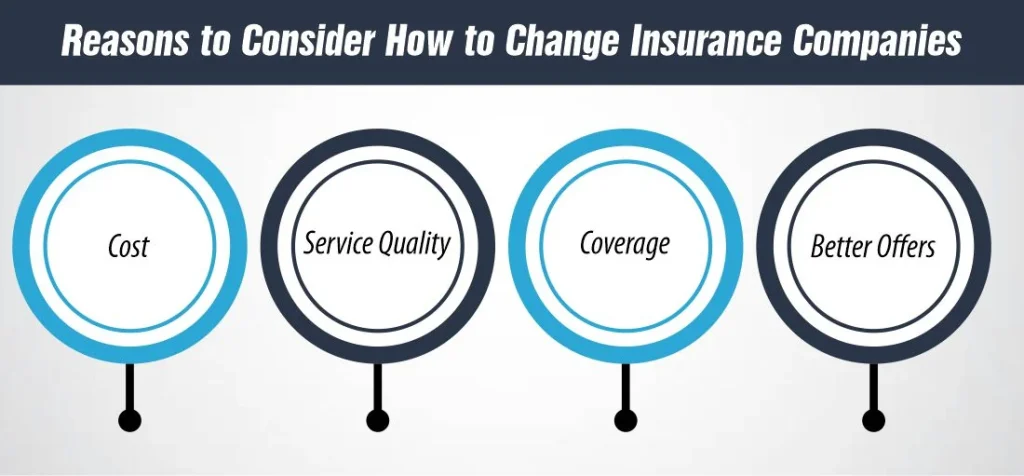Are you feeling stuck with your current insurance provider and wondering if there’s a better option out there for you? You’re not alone! Many people find themselves questioning whether they can switch insurance companies for a variety of reasons—be it cost, coverage, or customer service. Switching insurers might seem like navigating a maze, but it doesn’t have to be. What if I told you that changing your insurance company could be as simple as pie, potentially saving you money and boosting your peace of mind? Let’s dive into how you can make this switch smoothly and what you should consider before leaping.
Can I Change Insurance Company?
Yes, you can absolutely change your insurance company! Just like refreshing your wardrobe or updating your tech, switching your insurance provider can be a smart way to ensure your coverage still fits your life’s evolving script.
People consider a way to change Insurance company for several compelling reasons. Price is often the headline act—finding a policy that offers the same benefits at a lower cost can make a switch worthwhile. But it’s not all about the money. Sometimes, the service might feel like you’re stuck on a slow bus to nowhere, and better customer support can be found with a different insurer.
Life’s changes don’t stop at your doorstep either. Moving to a new home, changing marital status, or adding a teen driver to your policy can all reshape your insurance needs dramatically. Moreover, another insurer might dangle carrots like lower deductibles, improved coverage, or enticing perks your current policy doesn’t offer.
Change insurance company is a common strategy for those looking to align their policies with their current circumstances and goals. It’s all about finding coverage that fits like a glove in the ever-changing wardrobe of life.
 Reasons to Consider How to Change Insurance Companies
Reasons to Consider How to Change Insurance Companies
When thinking about switching insurance companies, several compelling reasons might nudge you to shop around and make a change. Here’s why and how to evaluate your options:
1. Cost
Cost is often the primary motivator for considering a change in your insurance provider. It’s wise to compare premiums and benefits offered by competitors regularly. Another company may offer the same level of coverage at a significantly lower cost. Discovering policies with better benefits for a similar price is also possible, which can increase your value for money. Keeping an eye on the insurance market can lead to substantial savings and enhanced coverage options.
2. Service Quality
The quality of service you receive from your insurance company can significantly impact your satisfaction and peace of mind. These are valid reasons to consider a switch if you’re experiencing ongoing issues like slow claim processing, lack of communication, or unsatisfactory customer support. Customer reviews, ratings from independent agencies, and word-of-mouth recommendations can guide you to insurers with a reputation for excellent service.
3. Coverage
Needs Life is full of changes, and your insurance coverage needs to adapt. Major life events such as getting married, moving to a new home, or adding a family member can alter what you need from your insurance. If your current company cannot provide the necessary coverage adjustments, or if these changes significantly increase your premiums, it may be time to look for a provider that better fits your new circumstances.
4. Better Offers
Insurance companies often roll out attractive offers to draw in new customers. These can include lower rates for the first year, bundles that offer more comprehensive coverage, or perks like discounts on other services. If you come across new incentives that would benefit you more than your current plan, this could be a strong incentive to switch providers.
Evaluating these aspects can help you make an informed decision on whether changing your insurance company could better meet your needs or offer you a better deal. Always weigh the benefits of a potential new policy against the stability and familiarity of your existing coverage.
Regularly reviewing and comparing your insurance options can save you money, improve your coverage, and enhance your customer service experience. If you find that other providers offer better costs, superior service, more suitable coverage, or enticing new customer deals, these are all valid reasons to consider switching.
Steps to Change Insurance Company:
Changing your insurance company doesn’t have to be a daunting task. With a clear plan and the proper documents, you can make the switch smoothly and ensure you’re always covered. Here’s a simple guide to help you change your insurance provider without any hiccups:
How Much Does Life Isurance Cost?
Step-by-Step Guide to Switch Insurance Companies
- Review Your Current Policy: Understand the terms, especially any fees for early cancellation. Know when your policy is up for renewal, as this is often the best time to make a switch.
- Shop Around: Compare offers from several insurance companies. Look at not only the prices but also the benefits, customer service ratings, and reviews.
- Choose a New Provider: Once you find an offer that suits your needs and budget better, decide on the new provider.
- Apply for the New Policy: Before cancelling your old policy, apply and get confirmation that your new policy is active to avoid any gap in your coverage.
- Notify Your Current Provider: Inform your current insurance company about your decision to switch and provide them with the necessary documentation for cancellation.
- Cancel Your Old Policy: Ensure this is timed correctly, ideally allowing your new policy to start as soon as your old one ends.
Necessary Documentation
To make the transition as smooth as possible, have the following documents ready:
- Personal identification (ID card, driver’s license)
- Current insurance policy documents
- Proof of address (utility bill or lease agreement)
- Recent claims history (if applicable)
- Payment information for setting up with your new insurer
Overlap Your Policies: Plan for a short overlap of your old and new policies. This prevents any period without coverage and gives you peace of mind.
Document Everything: Keep records of all communications with your old and new insurance providers. This includes confirmation emails of the policy activation and cancellation.
Update Your Records: If you’re switching auto or home insurance, update your lender or leasing agency and provide them with proof of the new insurance policy.
Switching your insurance provider can be a smooth and beneficial process if you plan correctly and stay organized. By following these steps, you’ll ensure that you’re never without coverage and can enjoy the benefits of your new insurance plan without any worries.
Potential Risks and Pitfalls
Switching insurance companies can offer numerous benefits, from lower costs to better service. However, navigating this change carefully is important to avoid potential risks and pitfalls that could leave you vulnerable.
Overlaps or Gaps in Coverage
One major risk when changing insurance providers is the possibility of experiencing gaps or overlaps in coverage. A coverage gap, even if just for a few days, can mean being unprotected during an incident, leading to out-of-pocket expenses for damages or losses that would otherwise have been covered. Conversely, overlapping policies can result in paying for two policies simultaneously, which is unnecessary and costly. Timing the end of your old policy and the start of your new one on the same day is crucial to avoid these issues.
Changing Terms and Conditions
Another risk involves the terms and conditions of your new insurance policy. Each policy has its own set of rules and coverage details. It’s vital to thoroughly understand these terms to ensure the new policy meets your needs. Changes in deductibles, coverage limits, and exclusions might take time to be apparent but can significantly impact your coverage.
Conclusion
Changing your insurance provider can be a strategic move that saves money and improves coverage. However, it has its challenges. To ensure a smooth transition and optimal coverage, be vigilant about managing the timing to avoid any gaps or overlaps.
Carefully review the terms and conditions of the new policy to confirm that it meets your expectations and needs. Given the complexities involved, consulting with an insurance professional can provide clarity and guidance. Making an informed decision on how you can change Insurance company will help you maximize the benefits of switching providers while mitigating any potential downsides.
References:

Expert Life Insurance Agent and health insurance agent
Dylan is your go-to guy for life and health insurance at InsureGuardian. He’s helped over 2,500 clients just like you figure out the best insurance plans for their needs. Before joining us, Dylan was sharing his expertise on TV with Global News and making a difference with various charities focused on health. He’s not just about selling insurance; he’s passionate about making sure you’re covered for whatever life throws your way.







